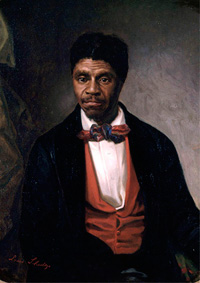Slavery: A National and Oregon Summary
Page Content
National Events
Slavery has been called America’s original sin, corrupting the culture and politics of the nation. By the early 1800s, the economies of northern and southern states had clearly diverged, with urban industries growing in the north and rural slave plantations dominating in the south. Over the decades, Congress tried to balance these two opposite and competing ways of life as the young nation expanded geographically to the west. It prohibited slavery in the new Northwest Territory around the Great Lakes in 1787 and practically set the Ohio River as the boundary between slave and free territory reaching west to the Mississippi River.
Much of the national struggle for the next 70 years revolved around a competition to admit slave and free states to the union. The Missouri Compromise of 1820 attempted to keep a balance of power by drawing an east-west line near the 36th parallel that allowed slavery below it and outlawed it above it. This Band-Aid on a festering wound failed to solve the underlying problems caused by slavery. The Kansas-Nebraska Act of 1854 effectively repealed it by allowing each new state south of the 40th parallel to decide whether to be a slave state or free state. Three years later, the U.S. Supreme Court went further in the
Dred Scott case, stating that the federal government lacked the power to regulate slavery in territories acquired after the creation of the country. This decision tore the Band-Aid off the slavery wound and the nation quickly descended into the Civil War.
 The U.S. Supreme Court denied Dred Scott's bid for freedom from slavery and further divided the nation in 1857.
The U.S. Supreme Court denied Dred Scott's bid for freedom from slavery and further divided the nation in 1857.
The Oregon Situation
While geographically distant from the national infection caused by slavery, Oregon was not immune. The growing divisions over slavery were imported to Oregon in the 1840s as waves of white settlers traveled west on the Oregon Trail with potently racist attitudes. These immigrants, betraying their Midwest and border state experiences, brought their hatred of slavery and free Blacks across the plains to their new homes. The great majority of these new Oregonians simply wanted to create an all-white society free of the racial problems threatening to cause an American civil war.
Amid the national turmoil, delegates to the Oregon Constitutional Convention in 1857 sought statehood to better control their own governmental destiny. They grappled with issues related to race and slavery throughout the proceedings. In the end, the delegates referred their questions to voters who overwhelmingly voted in November 1857 to prohibit slavery and ban free Blacks. Although the resulting laws were not really enforced, they still sent a message. Thus, while small numbers of Blacks were tolerated in Oregon throughout the mid 1800s, they struggled on the margins of society with few friends and fewer rights.